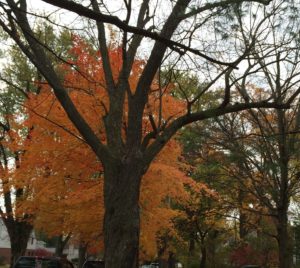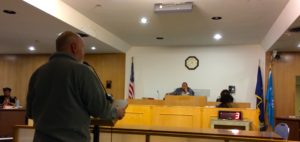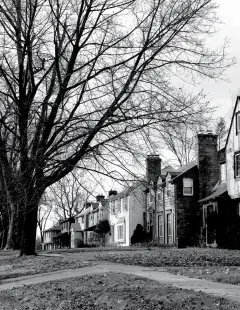By Jan Worth-Nelson
A group of College Cultural Neighborhood residents concerned about the recent disappearance of 180 trees from the parkways of their leafy neighborhood have been getting a tutorial on Flint city bureaucracy and politics in a water-crisis-dominated, post-emergency-manager era as they attempt to get answers from the city and the Genesee Conservation District.
In the meantime, tree cutting in the CCN has been called to a temporary halt by City Council–though the College Cultural Neighborhood Association representatives say that is not what they wanted–as conversations continue.
The story began last summer when Mike Keeler, long-time president of the CCNA and a college-trained wildlife biologist and Sierra Club activist, noticed a sudden proliferation of new stumps in the Seventh Ward neighborhood east of downtown.
Investigating further, on several afternoons biking the blocks north and south of Court Street, he counted and documented the locations of 180 new stumps. Some appeared indeed to have rotten cores, indicating they were dead or dying and candidates for removal.

Aging silver maple hanging on in the CCN last fall.
But a number also appeared healthy, making Keeler question who was deciding which ones to cut and why. As he probed further, he learned that many residents at the addresses of the stumps said they had not been notified before trees were cut, or they discovered a door hanger — sometimes after the fact — with no contact information for questions or follow up.
The College Cultural neighborhood is known for its trees. In fact, it uses the lush canopies on many of the neighborhood’s blocks as a selling point in an association brochure. The trees, many of them silver maples, were planted when the houses – a mix of colonial and Tudor designs – were built, mostly in the ‘20s and ‘30s.
The lifespan of a silver maple is about 75 to 80 years, so residents know their venerable trees have about run their course. In fact, the trees have been regarded by some homeowners as a liability, as brittle old branches crack off and tumble down, sometimes unexpectedly or in windstorms.
But Keeler said he wants to be sure when decisions about the trees are made, that they are made well and that residents have a voice. His concerns led to more research and questions. Early this year Keeler and three others attended a meeting of the Genesee Conservation District, a publicly elected body that partners with the city to manage its trees.
Residents learned that the recent proliferation of cut-downs represented the implemention of a 2015 urban forestry plan produced by an Ann Arbor consultant for the GCD, following completion of an inventory of the city’s 30,000 “street trees” on easements the city owns – known as parkways — between sidewalks and streets.
As Angela Warren, administrator of the GCD explained in a November article in East Village Magazine, the inventory, available on the city’s website, shows every street tree in the city, at least as of 2015. Residents saw that every tree was ranked, ranging from “good” to “dead.” And additional ranking classified 4,200 trees for immediate removal, 2,100 for “critical removal” and another 12,000 as needing “raises” – where overhanging branches are cut up from the bottom.
One of CCNA’s biggest complaints is what they say is a lack of communication between the GCD and the community.
“They never shared their plan to anybody,” Keeler told EVM. “Not MLive, the TV stations, nothing. What were we supposed to think when 180 trees are gone from our neighborhood? Did they think we wouldn’t notice?”
A tender point for many on all sides of the situation, as Keeler and others have noted, is that the 2015 forestry plan originally was set in motion by one of the city’s emergency managers, Mike Brown, who, as Keeler put it, “wasn’t required to let anybody know. He had his own powers.” Still, CCNA representatives said there could have been – and should have been – outreach from the GCD.
Among other clarifications emerging, Jeffrey Johnson, GCD senior conservation coordinator, acknowledged door hangers originally lacked contact information, and said that has been corrected.
Following the meeting with the GCD board, which Keeler said led to more questions and conflicts between the homeowners and GCD staff about which trees should come down, the homeowners invited their city councilperson, Monica Galloway, to a CCNA special meeting to discuss the situation.
Also attending that meeting were Fourth Ward Councilperson Kate Fields, Ninth Ward Councilperson Scott Kincaid, and Council president and Third Ward Representative Kerry Nelson.
After hearing the CCNA’s presentation, Nelson voiced support for the CCNA concerns, called for an immediate pause to the cutting and said he would write a letter to that effect to the GCD, who were not present, asking for answers to CCNA questions.

CCNA residents along with GCD representatives await Councilwoman Monica Galloway and City Council President Kerry Nelson at City Hall. (Photo by Jan Worth-Nelson, before she was asked to leave.)
After that meeting, however, the picture changed. Galloway convened a meeting between CCNA residents and representatives from the GCD, Warren and Jeffrey Johnson, senior conservation coordinator. City Council President Nelson also was present. Although the EVM editor, invited by the CCNA, was asked to leave the meeting, reports afterward were that after four hours, Nelson changed his offer about writing a letter. According to Keeler, Galloway did most of the talking.
Contacted afterward for comment, Warren said she was preparing a written response but EVM hasn’t received it.
Warren has contended throughout that, in a time of budget squeezes and limited resources, sometimes difficult decisions have to be made and that in some instances – based on six-year-assessments – keeping up maintenance of aging trees isn’t worth it.
In earlier articles in East Village Magazine, available here and here, she has explained that the removal of many trees last year in the CCNA was a coordinated part of the forestry plan adopted in 2015. She said the work was proceeding across four quadrants of the city, having begun in the north end and reaching the Seventh Ward last summer.
She said the work appears dramatic partly because of years of neglect, suggesting that there’s been a lot of catching up to do.
Another complication is that there are scarce resources for planting replacement trees – only enough for 100 new trees a year, Warren has said.
The CCNA residents next came to a Feb. 27 city council meeting at which a “special order” discussion about the trees occurred at Galloway’s request. Though 15 CCNA residents were present and had signed up to speak, and after disagreements between Fields, Galloway and Nelson about who could have the mic, only Keeler was given air time.

CCNA President Mike Keeler addressing City Council. (Photo by Jan Worth-Nelson)
Keeler’s two main points were that the GCD has not done an adequate job of communicating with the community about the trees and that the CCNA residents would like more emphasis on trimming, maintenance and replanting and less on cutting.
GCD administrator Warren introduced Dennis Bowles, the GCD forester who also had worked for the city for many years. He explained that the condition of some of the trees had altered since the forestry plan went into effect, leading to outcomes that don’t always match the inventory categories.
“Trees are dynamic,” Bowles said. “As time progresses, things change.”
Fields informed the rest of the council that one of the foresters on the GCD staff, Erica Barlow, is related to the owner of J&B Tree and Yard Service, one of five contractors used by the GCD for tree maintenance, and called it a conflict of interest. Nelson agreed this was an issue to look into.
After an hour of questioning by council members, the tree matter was referred to the council’s “government operations” committee.
Contacted afterward, Council President Nelson said, “The council is not the right frame for these discussions. We are by no means trying to take this off the books. I feel we made some progress in our discussions, but it belongs better in committee.”
In the meantime, the city council has instructed the GCD to stop cutting trees, in the Seventh Ward only, while negotiations, information-gathering, and meetings continue.
However, Nelson noted, “If they’re city-owned trees, the city could cut down all the trees if they want.”
Keeler had a lot to say about that.
“This is not what we wanted,” he said in exasperation. “We’re looking out for all the trees in the city, not just in the Seventh Ward – this is not just a Seventh Ward issue.”
“We know it’s a city easement,” he said. “But they have to realize we ARE the city. We’ve put our own sweat equity into these trees — the leaves we rake, the money we spent to get the roots out of the drain. You owe us the respect that if you’re going to cut the tree down, talk to me, talk to us, and let us have some input – we might be able to compromise. “
“If they only base their decisions on dollars and cents,” he added, “the tree loses every time. But their own plan also says you can’t just do that – you have to include the environmental benefits, the energy savings, how the house is going to be shaded, how it blocks the wind in winter time, reduces CO2, emits oxygen, helps keep storm water runoff from being overloaded, not to mention the aesthetics – our neighborhood values.
“When you take all of those into consideration, the tree wins every time.”
Asked what he has learned so far in the process, Keeler said, “We’ve learned that the city is dysfunctional.
“We tried to go through the system – we’ve spent a lot of emotional time with this,” he said, “and we got nowhere. We’re not done. There’s probably other ways to get things done.”
EVM Editor Jan Worth-Nelson can be reached at janworth1118@gmail.com.



You must be logged in to post a comment.